
Horses
Companions, Competitors, & Working Partners!

Horses
Companions, Competitors, & Working Partners!
Flowing manes and tails, rippling muscles, thundering hooves, and high spirits, horses today epitomize beauty, athleticism, and freedom, offering companionship, joy, and working partnerships to millions of owners, riders, and carriage drivers.
But that’s not all! Beyond these qualities lie the inexplicable attraction of a warm horse body, the heady perfume of horse sweat, and the joy of a soft nicker in the human ear.
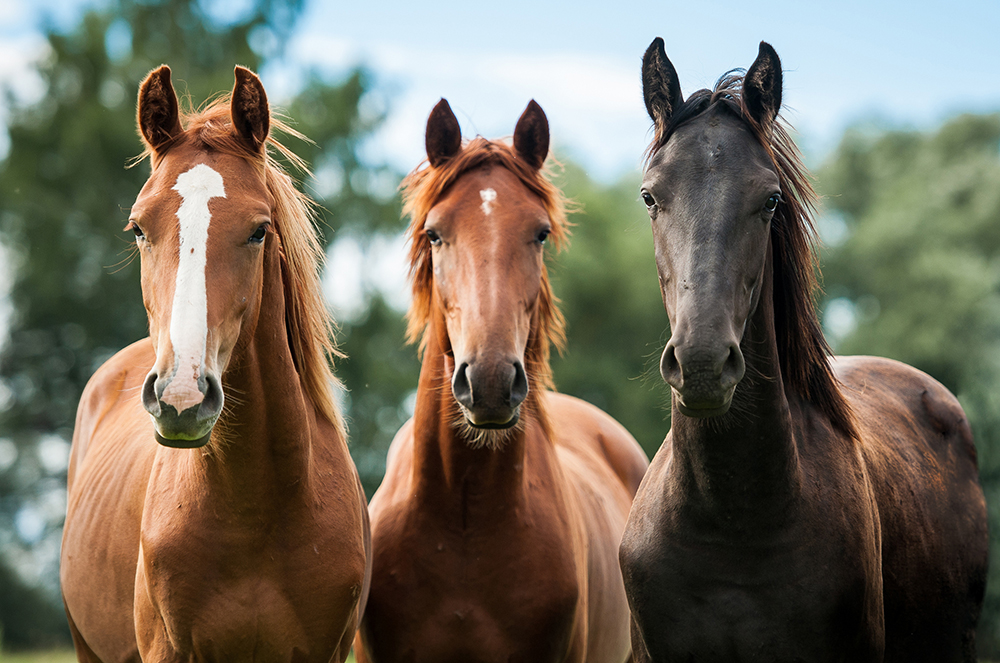 Horses offer companionship, joy, and working partnerships Horses offer companionship, joy, and working partnerships
|
And there’s more! Equine beauty is definitely more than skin deep; their intelligence, courage, and willingness to be domesticated gave horses an unequaled role in the development of civilization as well as a place in our hearts.
Horses have roamed the earth for millions of years in one form or another. Originally forest dwellers browsing on leaves, these Eohippus or Dawn Horses evolved into the beautiful creatures we know today.
Clues such as cave paintings and buried bones and artifacts hint at the early relationship between humans and horses. First hunted by primitive man then probably raised for meat and milk, horses accepted domestication and became vital to human progress as haulers of people and goods, tillers of the fields, and warriors in battle. For thousands of years, man has celebrated these valued animals in art, embraced them in folklore and featured them in literature. The result? A practical association that morphed into a spiritual one with an unbreakable bond between our species and theirs.
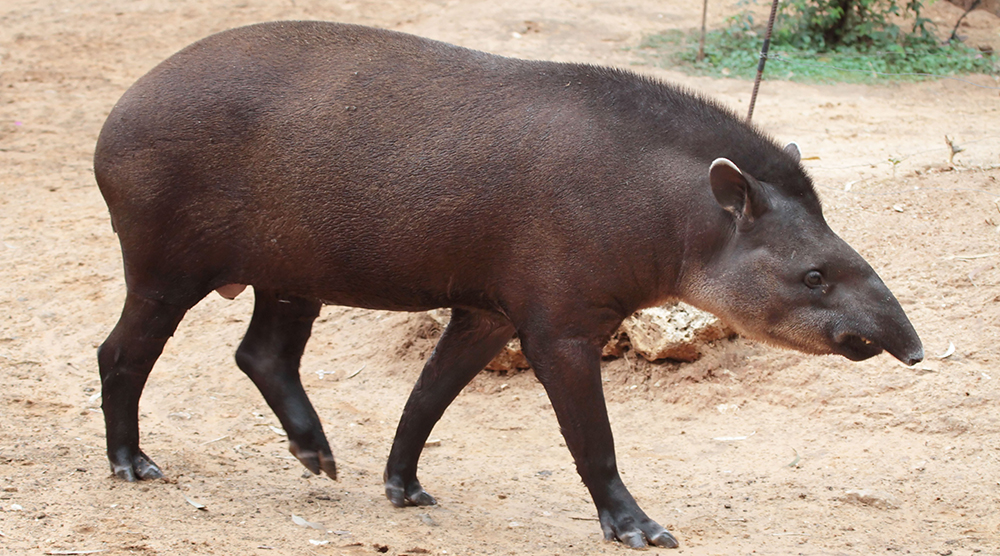
Fifty million years ago, the horse’s ancestors were small woodland herbivores browsing on leaves, but climate fluctuations led to the expansion of wide open grasslands and beckoned them into the open. Over time, horses changed in size, diet, and adaptations, and the dozen or so species dwindled to a handful then to one: Equus ferus, subspecies caballus, the modern horse.
Fossil evidence indicates that horse ancestors appeared in North America and spread across a land bridge to Asia, then died out on the American continent about 11,000-13,000 years ago. By that time, the species were well-represented in Asia and Europe.
The journey from forest to plains transformed the horse from a five-toed animal the size of a small deer to a single-toed animal weighing 1000 pounds or more. Jaws and teeth suited for eating leaves became jaws and teeth capable of chewing tough grasses; feet suited for soft, spongy forest ground became hooves adapted to firm, dry open land; and legs elongated to provide the speed and agility to escape predators.
Domestication of the horse probably occurred in the Eurasian Steppes in what is now Russia, the Ukraine, Kazikstan, and Western Europe beginning about 10,000 years ago. Research has failed to identify a living equine species as its direct ancestor, but based on DNA carefully extracted from equine bones found in the Siberian permafrost, scientists speculate that all domestic horses derive from a single wild species.
For many years, scientists considered the Mongolian equine known as Przewalski's horse to be the progenitor of the domestic horse, but recent research proved that assumption to be false. Przewalski's horse has 66 chromosomes, two more than domestic horses, and is now considered a distant cousin. The Tarpan, a wild horse of Europe and Asia, might fill the role of ancestor, but it died out late in the 19th Century.
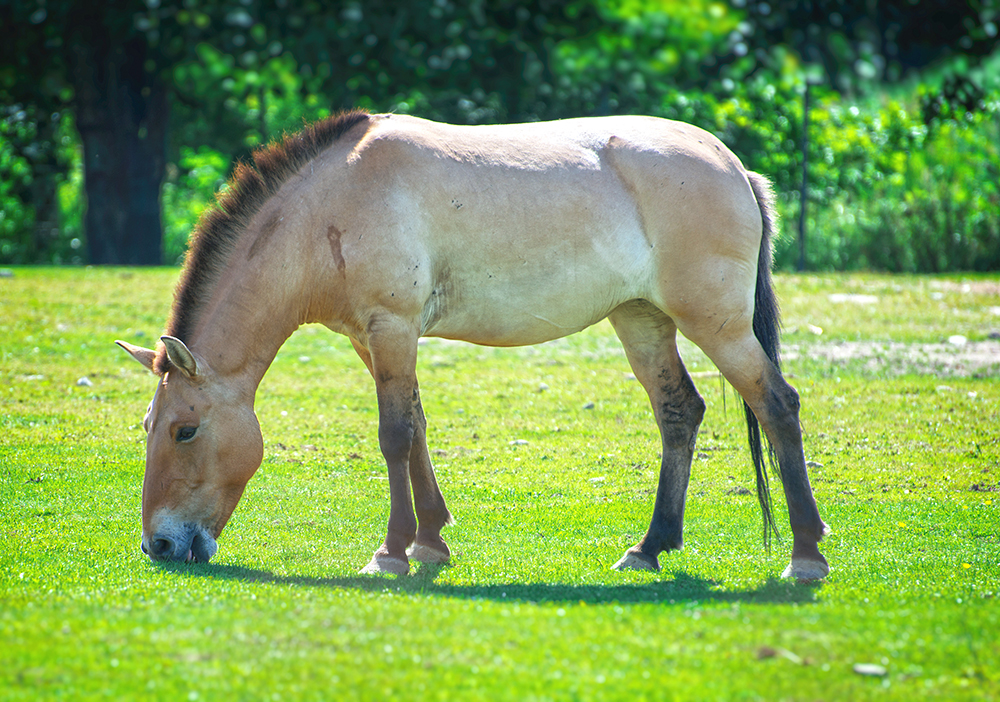 Przewalski's horse: NOT the progenitor of the demestic horse. Przewalski's horse: NOT the progenitor of the demestic horse.
|
There are no true wild horses today, even in the western United States. The horses labeled “wild” are actually feral, that is, they are domestic horses that escaped or released or are the offspring of those free-ranging unowned domestic horses. When recaptured, these horses quickly build an association with people; the US Bureau of Land Management reports dozens of success stories of adopted horses trained for competition or work in a variety of sports and activities.
The horse is a paradox among domestic animals. A marvel of adaptation, it is wary, easily startled, and fleet of foot and has honed flight as a survival strategy. Yet, despite these traits, it accepted a partnership with humans and became a key player in the progress of human civilization. It was a trade-off to be sure; horses got food, shelter, and protection from predators, and man got food, transportation, farm labor, and an advantage in battle.
Initially, humans kept horses for meat and milk. Somewhere along the way, they learned to harness the animals to chariots, carts and sleds and finally to ride. Use of horses improved human chances of survival in harsh climates, allowed ancient peoples to travel further and swifter than before, and gave them an advantage in battle.
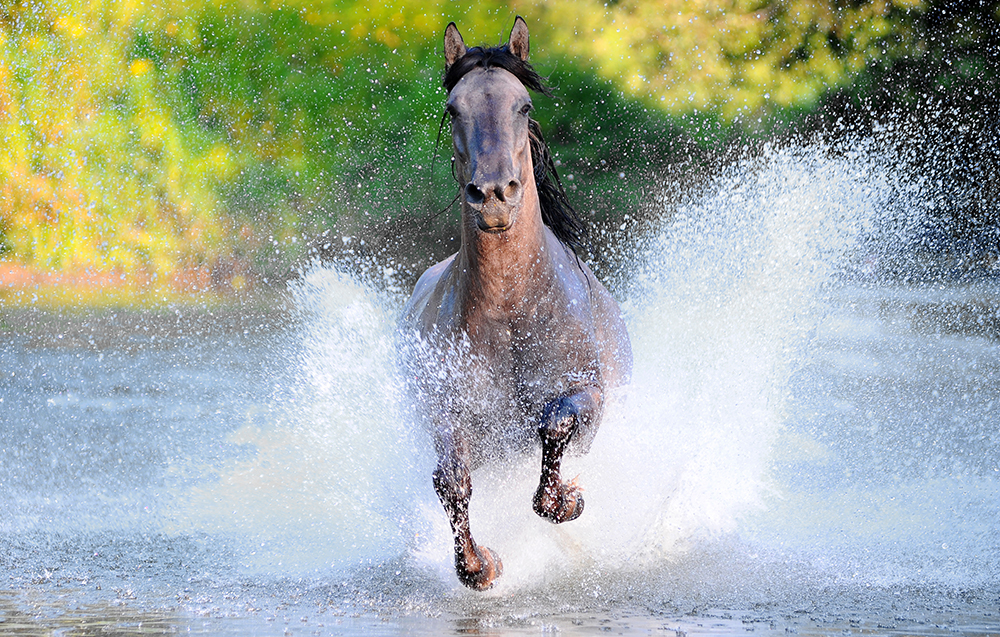 A feral horse splashes in the surf. A feral horse splashes in the surf.
|
Early on, man divided horses into types with heavier animals pulling plows and wagons and lighter ones for such activities as chariot races and riding.
In Biblical times and before the Middle Ages, horses were mainly used by kings and armies. Farmers used oxen to pull carts and plows, and villagers sometimes rode donkeys, but horses were expensive and reserved for royalty and battles.
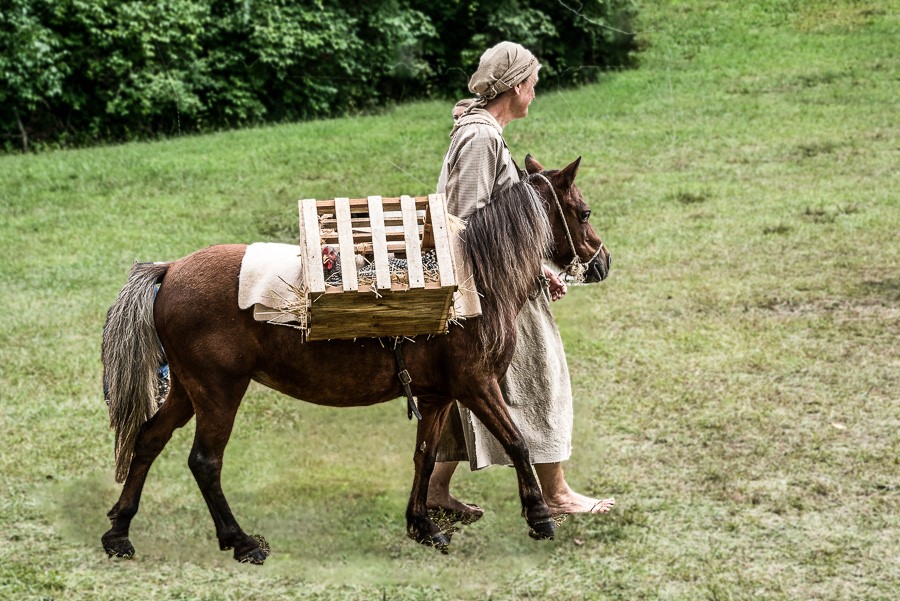 History buffs re-enact life in early settlements. Here, a farm girl’s pony carries baskets of chickens to market. Photo by Thomas Woolf. History buffs re-enact life in early settlements. Here, a farm girl’s pony carries baskets of chickens to market. Photo by Thomas Woolf.
|
The use of horses bloomed in the Middle Ages, the 1000 years spanning the 5th Century to the 15th Century. During this period, Europeans used horses to pull plows, haul people and goods, and transport hunting parties, and began to breed horses for distinct purposes. They divided horses into categories: destriers were large, sturdy, well-trained horses used in battle and jousting tournaments; palfreys were lighter, smooth-gaited horses used as everyday horses for knights and often ridden by ladies; coursers were lighter, swift horses used as messengers in battle and when speed was necessary; and rounceys were used by farmers. Some breeds existed already and others developed from these basic types.
Horses returned to the Americas at the end of the Middle Ages with Spanish explorers who landed on Caribbean Islands and in South America. Horses arrived in Hispaniola (the Caribbean island divided into Haiti and the Dominican Republic) and Cuba with Columbus in 1493, and additional Spanish and Portuguese explorers and missionaries brought horses from home in the decades from 1509-1620. Some of these voyagers searched for gold and other treasures in Central and South America and Mexico and put their horses to work in the mines. Others established breeding ranches and built great estates and a reputation for producing fine horses that survives today.
Hernando De Soto brought more than 200 horses to Florida for his march into the southeastern portion of the country from 1539-1543. Other explorers such as Ponce de Leon, Hernan Cortez, and Francisco Pizarro each brought horses along for their New World expeditions. Descendants of these horses spread throughout the western US where they became linchpins in settling the vast lands west of the Mississippi River.
Beginning in 1620, British, French, and Swedish settlers brought work horses to the eastern US coast to plow the fields, provide transportation, and allow speedy communication between their growing villages. Most colonial horses were farm animals, but they also transported people and goods, especially as towns grew and industry began to thrive. Some horse owners naturally gravitated toward horse racing as a form of entertainment and status.
A Massachusetts government official established a breeding center for Narragansett Pacers in Rhode Island and launched the colony’s reputation as a horse-producing center. The Narragansett Pacer, America’s first breed, provided a smooth gait and became a favorite of plantation owners throughout the seacoast colonies and Caribbean islands.
Horses also provided the main contact between communities in the colonies. Post riders traveled from settlement to settlement on rutted, muddy roads, and allowed communications until better roads allowed the development of stagecoach routes. Doctors also used horses to make their rounds, and circuit judges and traveling merchants used horses to move between farms and villages.
Did you know?
An avid fox hunter with a stable of fine horses, General George Washington created the American Foxhound to trail the quarry over the Virginia countryside.
In the mid-18th Century, gentlemen, ladies, and members of the middle class used horse-drawn riding chairs as transportation and well-to-do families had coaches. Most of the horses were crossbreds, but Thoroughbreds and Quarter Horses were gaining in popularity. Several of the country’s Founding Fathers enjoyed horse racing, and President George Washington was an expert rider.
Horses were essential to both the British and American armies in the Revolutionary War. Both armies also used horses to move artillery and supplies, but prior to the war, mounted units were mostly ceremonia. General Washington quickly realized that horsemen could be useful for patrolling the eastern coast to scout for possible British landings.
Washington accepted an offer of several volunteer cavalry units, but the initial regiments had problems. The British used cavalry to defeat the Continental Army in New York, leading Washington to form his own mounted detachments.
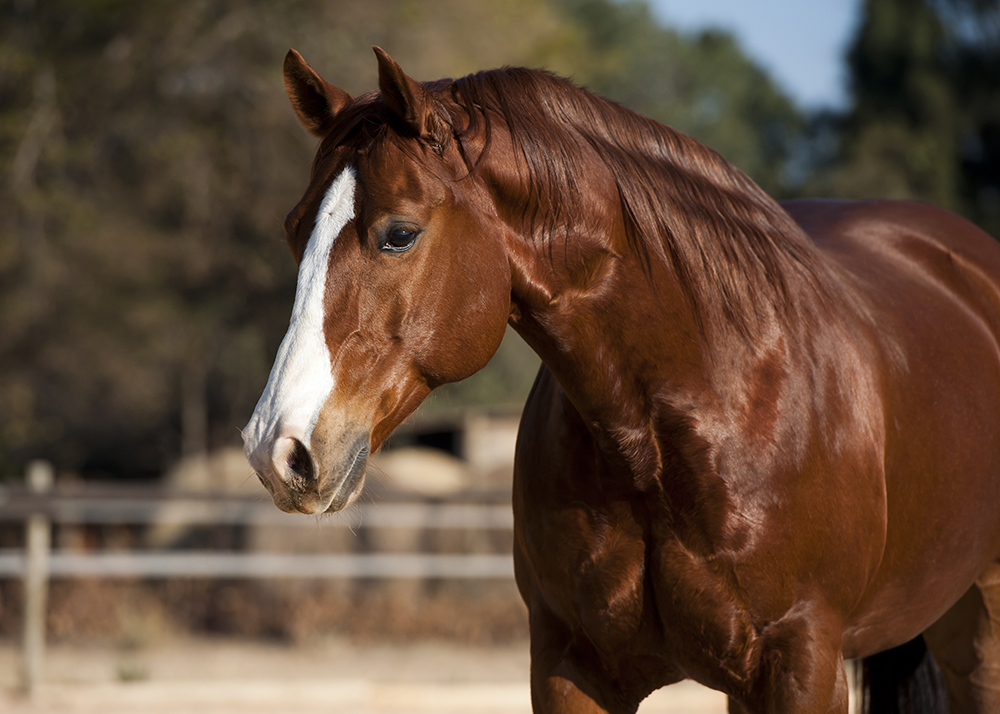 The Quarter Horse is the Quintessential American Breed. The Quarter Horse is the Quintessential American Breed.
|
The story of the horse in the American West is the story of the Quarter Horse, the quintessential American breed. Named for the quarter-mile length of the typical colonial race track (often just the main street in town), the Quarter Horse was a combination of the Spanish horses brought into Florida by explorers and colonists and Thoroughbreds brought from England to add speed. Mustangs descended from Spanish horses that entered the US through Mexico put the finishing touches on the breed. Easy to ride, agile, tough, and intelligent, the breed helped open land from the Mississippi River to the Pacific Coast. Especially valued for ranch work and cattle drives, Quarter Horses also pulled plows, carried buffalo hunters, and served a variety of other purposes.
Horses continued to be indispensable until development of mechanized travel, first railroads, then automobiles. They carried riders over roadless countryside and pulled carriages along dirt thoroughfares. Horses pulled stage coaches that carried people, gold, and merchandise from town to town and covered wagons that moved thousands of settler West after the Revolutionary War. Horses also powered the US Cavalry, the mounted units that became part of the American army in 1855, served in the US Civil War, protected settlers from Indians and outlaws, and served the country until World War II.
Despite its short run from April 1860 to October 1861, the Pony Express is as much an icon of the American West as stagecoaches, cavalry, and cattle drives. A private venture born of the need for quicker communications in the months before and in the early days of the Civil War, the service could carry mail 2000 miles from Missouri to California in 10-11 days.
Founded by the owners of a freight company, the Pony Express used a series of relay stations to house fresh riders and horses. Each horse and rider team carried sacks of mail between stations set 90-120 miles apart. They used about 400 horses of several breeds and crosses, including Thoroughbreds, Mustangs, and Morgans.
The Pony Express died with completion of the telegraph line from Missouri to Sacramento, California, but it lives on as an American legend. Buffalo Bill Cody included the Pony Express in his wild west show and Wild Bill Hickok was associated with both the Pony Express and the Cody show. Both of these larger than life men contributed to the glory of the Pony Express that belies its brief existence.
Native Americans first saw horses when the animals came to the southwestern corner of the country with Spanish explorers. Native tribes revered the animals as spiritual symbols; when some of the horses escaped the conquistadores and their followers, the natives learned to capture and tame them. The relationship between the natives and the horses changed tribal life; instead of hauling goods on their backs or with dogs, they could use horses to pull travois or wagons, and instead of hunting on foot, they could find and chase bison and other game on horseback. Members of many tribes became expert horsemen, an advantage in fighting other tribes and the hordes of settlers and their protectors who headed west after the Revolutionary War.
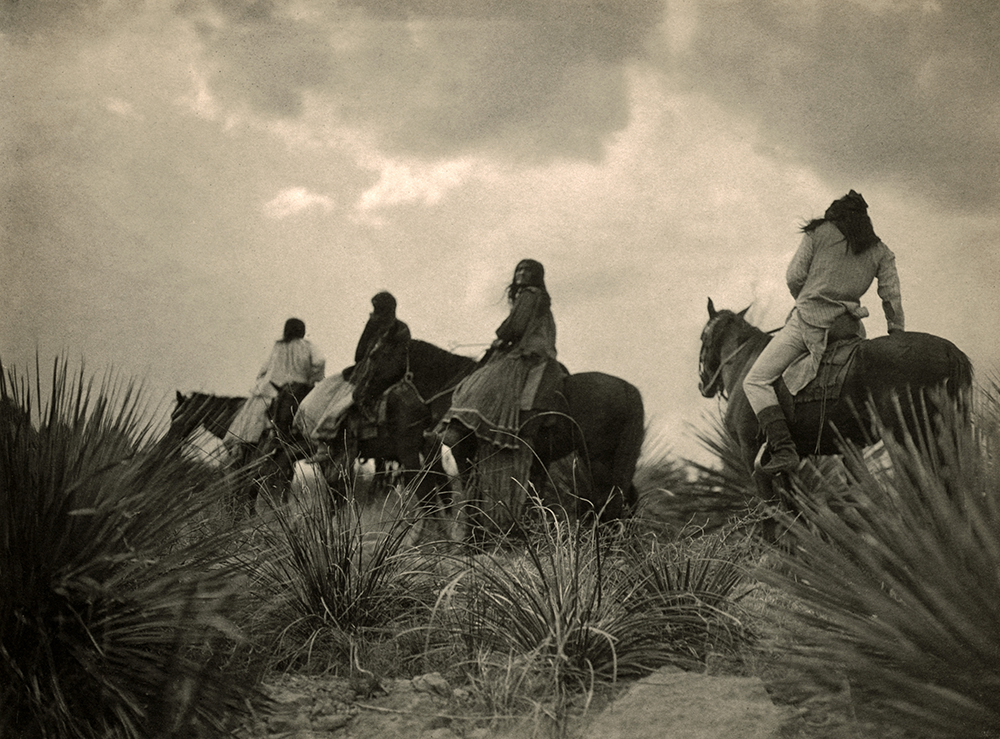 After the introduction of horses to the Americas, members of many Native American tribes became expert horsemen. After the introduction of horses to the Americas, members of many Native American tribes became expert horsemen.
|
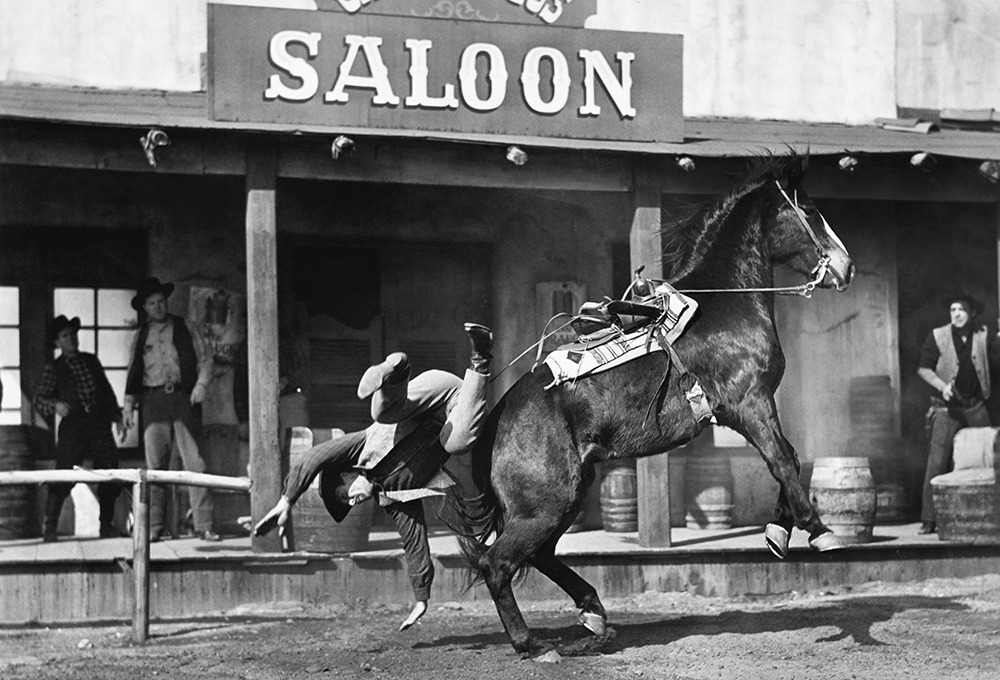 Horses have long been featured players in literature and cinema -- especially westerns. Horses have long been featured players in literature and cinema -- especially westerns.
|
The western genre has drawn readers and movie-goers to books and films for generations. The freedom of the wilderness, the stoicism of cowboys and lawmen, the romanticism of outlaws, and the gradual taming of the West depended on horses … horses to herd cattle and carry cowboys and soldiers and native warriors, horses to pull carriages and coaches, horses to tame, and horses to personify as symbols of friendship and liberty and independence.
Writers such as Zane Grey, Walter Farley, and Marguerite Henry drew readers into a world where horses reigned supreme. Grey’s novels influenced Hollywood producers and directors and opened the door to hundreds of films about the West, films that launched and furthered careers for John Wayne, Randolph Scott, Gary Cooper, William Powell, Fay Wray, Wallace Beery, and other actors and movie makers.
Where Grey’s novels used horses as parts of the stories he told about the Wild West, Henry and Farley used horses as characters in their own right: Henry wrote of the horses of Chincoteague, the Godolphin Arabian, and Justin Morgan’s horse, and Farley profiled individual horses in his Black Stallion series of novels. Many of Farley and Henry’s books are considered among the most popular horse stories of all time.
The horse’s physical characteristics allow it to survive in the wild, adapt to life on the farm, ranch, and racetrack, and equip it to work with and for people in a variety of activities. These characteristics include:
Horse hooves are remarkably complex. Each hoof is a toe with an outer layer of specialized hairs that mat together and form a hard pad that protects the softer inner part of the digit. Like human hair and fingernails and rhino horns, the hoof wall has no feeling and continues to grow throughout the life of the animal.
The horse walks on tiptoe; its “ankle” is the fetlock joint above the hoof. Inside the hoof wall and extending to the fetlock joint, the foot contains bones, cartilage, tissues, and tendons that absorb the shock of a pounding gait, help with blood circulation in the lower limbs, maintain foot health, and provide support.
The hoof is actually the third (middle) of the five toes of its forest ancestors; it not only bears the horse’s weight, it allows the animal to fully extend its limbs while running. The first, second, fourth and fifth toes remain but are shrunken in size and have no purpose.
Early domestic horses had stocky bodies, thick necks, and short, stiff manes and were mostly a variation of dun color. Domestication brought mutations that resulted in additional patterns and colors. Today horses are white, grey, cream, golden, red, brown, dun, and black and some colors in between. They can be solid color with mane and tail of the same or a different shade, and may have white markings on faces and lower legs; they can be pinto or paint (patches of color on a white background or splashes of white on a colored background) or spotted. Several breeds of horses carry pinto pattern genes, but only the pintos with at least one parent registered with the American Paint Horse Association, and one parent registered with the American Quarter Horse Association, or the Jockey Club (thoroughbreds) are considered members of the Paint Horse breed.
Several breeds also display the variation of chestnut known as palomino, a genetic characteristic that dilutes the intensity of the red color. A palomino is a shade of gold with a light mane and tail and can be a Quarter Horse, a Tennessee Walking Horse, Morgan Horse, or Saddlebred. The Palomino Horse Association and the Palomino Horse Breeders of America register palominos.
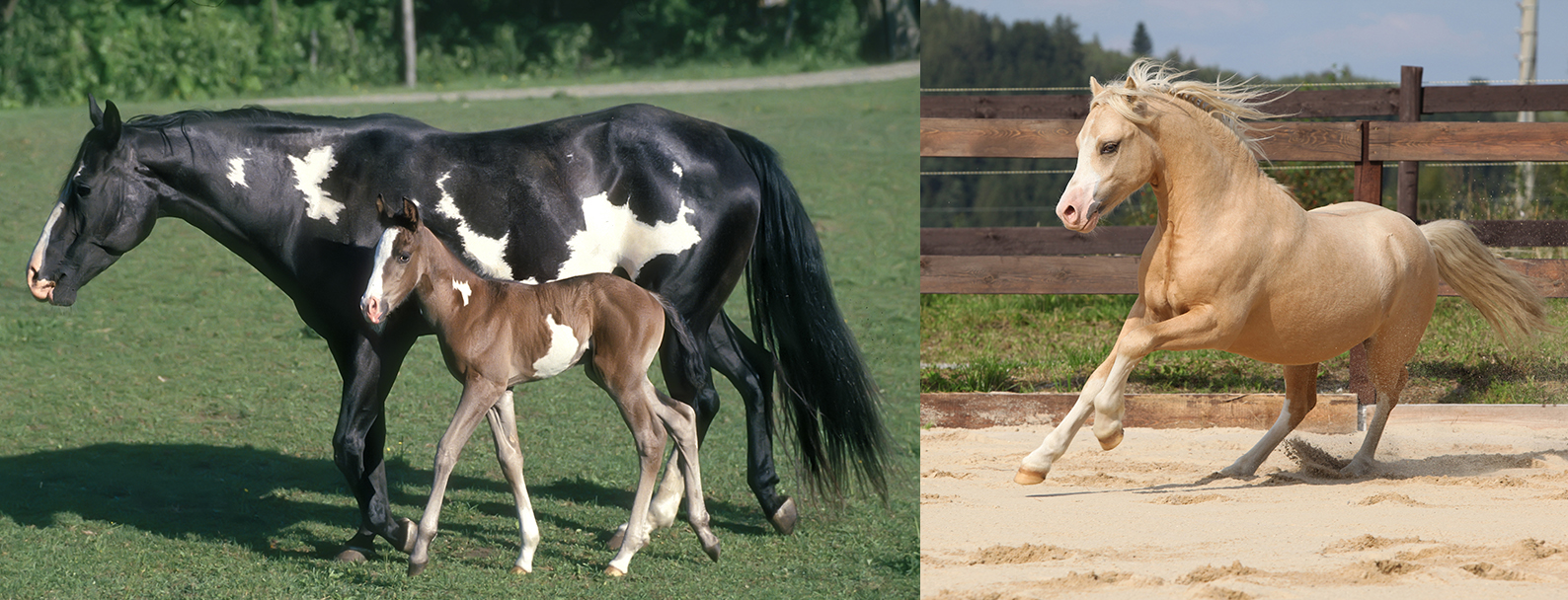 Paint horse and foal on left, palomino on right. Paint horse and foal on left, palomino on right.
|
A horse’s height is measured at the withers, a point at the top of the shoulders between the neck and the back. The unit of measurement is a “hand,” a span of four inches.
The horse must be standing on level ground when measured. The easiest procedure is to use a horse measuring stick that records the height in inches and then convert the inches to hands by dividing by four.
Horses generally range from 15-18 hands tall (i.e., 60-72 inches at the withers) and ponies are less than 15 hands tall. The Shire is the tallest breed at 16-18 hands (up to six feet tall at the withers).
Breeds
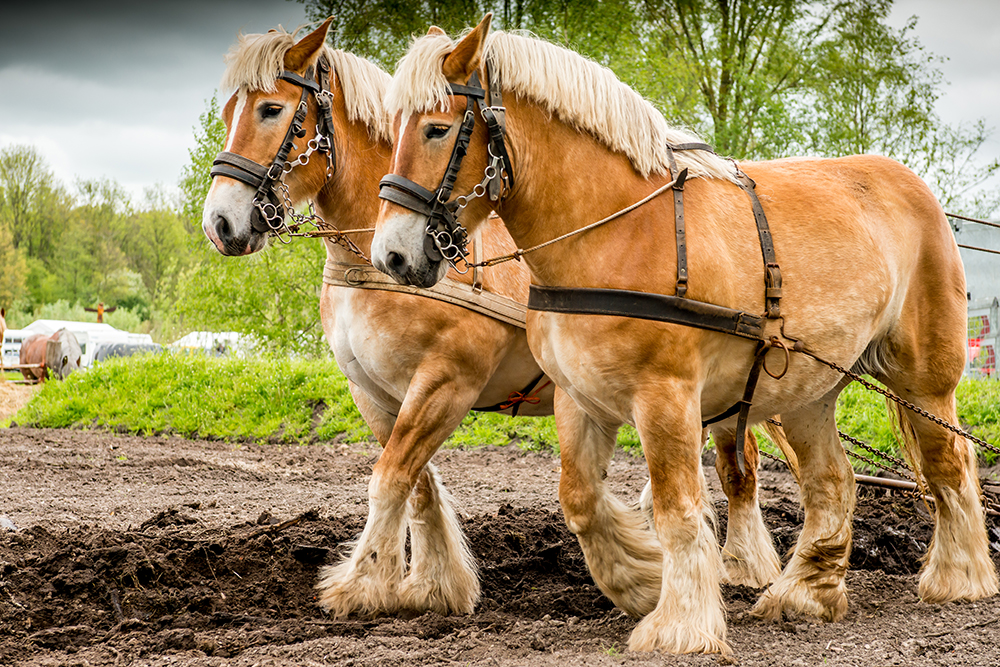 Draft horses are large, powerful, and able to resist the elements -- but also calm and gentle. Draft horses are large, powerful, and able to resist the elements -- but also calm and gentle.
|
A horse is not just a horse, of course. Although all horses have the same general shape and behaviors, man has refined their size, athletic ability, and trainability to meet human goals throughout the centuries of domestication. Most breeds have had many careers. Some have gone from tilling fields to hauling wagons to pulling carriages. Others have worked farms and carried warriors.
Horses are generally sorted into three groups: heavy or draft horses originally used to carry knights in armor and pull heavy wagons and equipment (also known as cold-blooded horses), light horses for riding and pulling carriages (also called hot-blooded horses), and medium-weight horses for long-distance travel and cross-country sports (also called warm-blooded horses). There is, however, some crossover; some draft horses are ridden and some light and medium horses pull carriages.
Most draft horse breeds originated in northern Europe and are able to withstand harsh weather and colder temperatures. Despite their size and power, they are well-known for their calm and gentle nature. Draft horses can be large or compact, but regardless of size, they have thick, muscular necks, powerful shoulders, and rounded hindquarters that enable them to haul heavy loads. Large draft horse breeds include the Shire, Suffolk Punch, and Clydesdale from Great Britain, the Percheron from France, and the Belgian from Belgium. Compact breeds include the Bashkir from Russia, the Fjord Horse from Norway, the Haflinger from Austria, and the Ardennais from the France-Belgium border country.
Known for their speed, intelligence, stamina, agility, and courage, light or hot-blooded horses developed in warmer climates and have finer coats and lighter bodies than their cold-blooded cousins. These are the quintessential horses for pleasure rides, light carriage work, and racing and other athletic contests. Hot-blooded breeds include the Arab, an old breed born in the Middle Eastern deserts, and the Barb, a North African breed, the Thoroughbred, Tennessee Walking Horse, Morgan Horse, and Standardbred. Some of these breeds were crossbred with others to hone desired traits: Arabians influenced the Thoroughbred, Quarter Horse, Morgan, Saddlebred, Appaloosa and Trakehner breeds; Thoroughbreds and Morgans in turn contributed to the crafty development of the Standardbred and Saddlebred breeds. The Barb contributed to the Thoroughbred, Andalusian, and American Mustang.
Warm-blooded horses fill the gap between the other two types, but there is much overlap between hot-blooded and warm-blooded breeds. For example, the Quarter Horse, Andalusian, Lippizaner, and Cleveland Bay have characteristics of both groups.
Breeds such as the Trakehner, Hanoverian, Oldenburg, Danish Warmblood, Swedish Warmblood, and Dutch Warmblood are are classified as warmbloods and are used for steeplechase races, three-day events, stadium jumping, and dressage.
 Ponies: friendly, crafty, and sometimes stubborn... Ponies: friendly, crafty, and sometimes stubborn...
|
Ponies are small horses of a particular body type: they are generally less than 58 inches tall at the withers and have thicker coats, manes, and tails; heavier bones, thicker necks, and shorter heads than horses. They are hardy and sure-footed and can be friendly, stubborn, or crafty.
Pony breeds developed at the fringes of horse-friendly environments. For example, the Shetland Pony came from the Shetland Islands, a remote set of islands north of Scotland, and the Connemara is native to a harsh landscape in the west of Ireland. Other pony breeds include four types of Welsh ponies, Caspian ponies from the Middle East, the Dartmoors from England, and the Pony of the Americas.
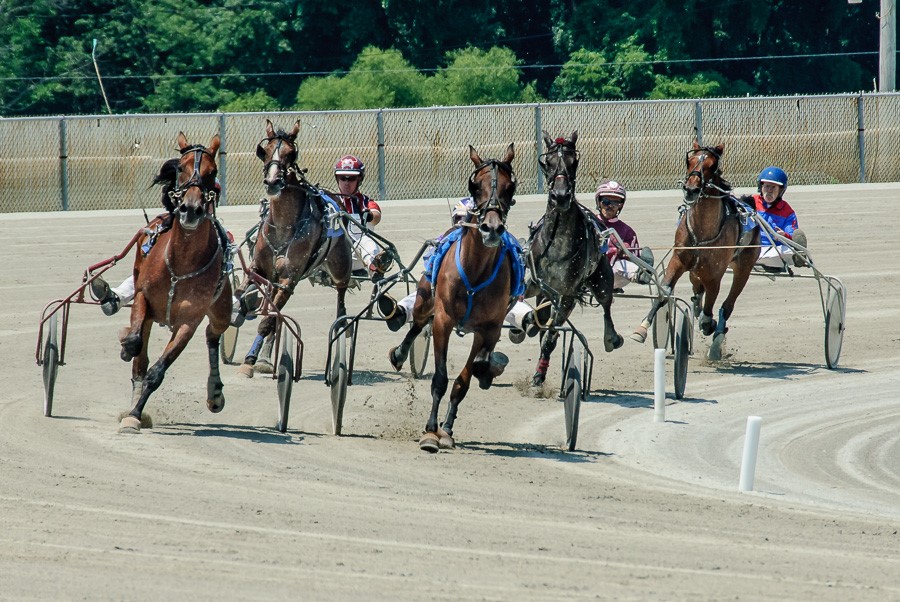 Trotting races are popular at county fairs and racetracks throughout the country. Photo by Thomas Woolf Trotting races are popular at county fairs and racetracks throughout the country. Photo by Thomas Woolf
|
Although horses are no longer an integral part of daily life for most people, these remarkable animals still have an affinity for teamwork with us in a variety of jobs and activities and draw our attention wherever they appear. Some horses provide a living for trainers, drivers, riders, and caretakers in racing stables, carriage companies, breeding stables, vacation ranches, riding stables, and rodeos. Others enable their owners to participate in sports such as cross-country and stadium jumping, carriage-driving, polo, and exhibitions of western and English-style riding skills. Horses also demonstrate their contributions to agriculture and transportation on living history farms and other educational settings; provide power for plows, wagons, and log skids on small farms and homestead; and help police with crowd control.
Horse owners, horse-related businesses, and the groups and clubs they join and support are today’s leaders in horse welfare. They develop standards of care, share tips about behavior and training, improve their knowledge at seminars and clinics, help each other when hard times strike, and donate to horse health and safety research. Associations such as The Jockey Club, the governing body of Thoroughbred racing, various breed and event organizations, and the American Association of Equine Practitioners enact policies governing horse welfare. Egregious violations of event association policies can result in suspension from the group’s activities and investigation by local, state, or federal authorities.
Horse racing is big business employing trainers, stable workers, jockeys, farriers, veterinarians, exercise riders, and track workers, providing a market for everything from saddles and bridles to hay and sweet feed, and offering thrills and entertainment for millions of owners, bettors, and fanciers. Tracks all over the country hold race dates for Thoroughbreds ridden by jockeys and additional tracks and county fairs host sulky driven Standardbreds in trotting and pacing contests. The industry contributes $25 billion to the country’s economy and generates more than 350,000 jobs.
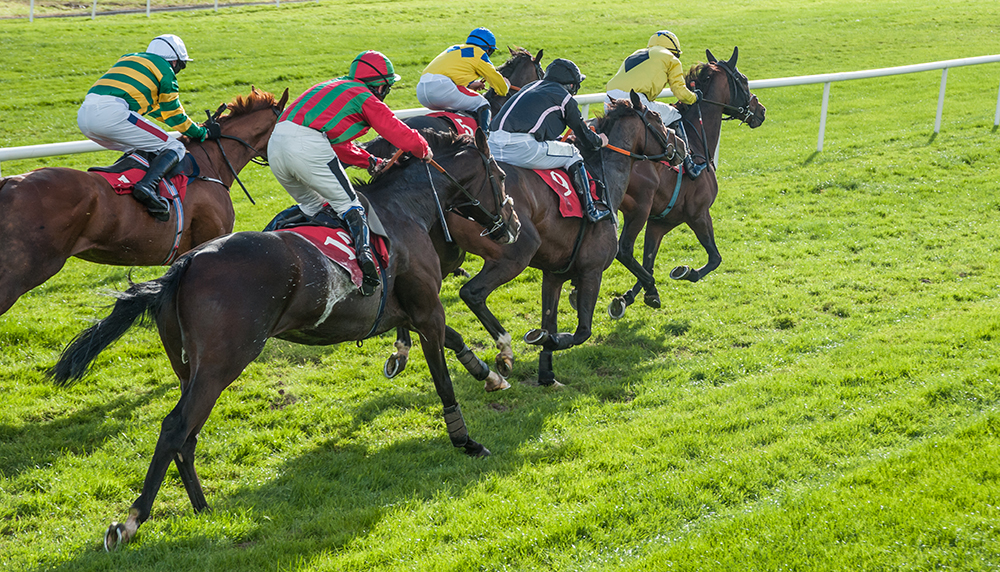 Horse racing generates billions for the US economy and sustains more than 350,000 jobs! Horse racing generates billions for the US economy and sustains more than 350,000 jobs!
|
As with other sports and animal-related businesses, those who love the horses they work with are their champions and guardians. The Jockey Club sets the standards for Thoroughbred horse racing, including maintenance of the Thoroughbred stud book and organizing or participating in initiatives to maintain the integrity of the sport, provide for horse and rider safety, and promote care for horses that have retired from racing. The Grayson-Jockey Club Research Foundation funds research and conducts an annual summit on horse health issues ranging from diseases and structure to safe surfaces and injuries.
Horse racing is highly regulated by state racing commissions that require owners and breeders to apply for a license. Along with the Jockey Club and affiliated programs, the industry offers benefits for breeders, owners, and prospective owners through the programs, clinics, and seminars of the Thoroughbred Owners and Breeders Association.
The world of horse racing expands each spring with the challenging Triple Crown races for three-year-old Thoroughbreds. The triad of races begins with the Kentucky Derby in early May, followed by the Preakness Stakes in Maryland in mid-May and the Belmont Stakes in New York in early June. Trainers who prepare horses for these races, the jockeys who ride in them, and sometimes the horses themselves reach celebrity status. People who pay little or no attention to horse racing during the remainder of a year are often familiar with the horses, jockeys, trainers, and owners of horses entered in Triple Crown races. The reward for this heightened interest came in 2015 when American Pharoah’s three breathtaking runs gave him the Crown after a 37-year drought.
Horses can live for more than three decades, but their racing careers are short. Those that do not go to breeding farms may find a home through the Thoroughbred Retirement Foundation. Some of these horses enjoy a second career on the polo field, in dressage or three-day eventing, as working police horses, participants in equine-assisted therapy programs, or as pleasure riding pets. TRF also provides horses to prisons in several states so that inmates can learn horse care skills and increase their chances of finding employment when their sentences are finished.
The United States Trotting Association serves a function similar to that of the Jockey Club for the owners, trainers, and drivers of harness horses, including finding new opportunities for retired Standardbreds through its Standardbred Safety Net.
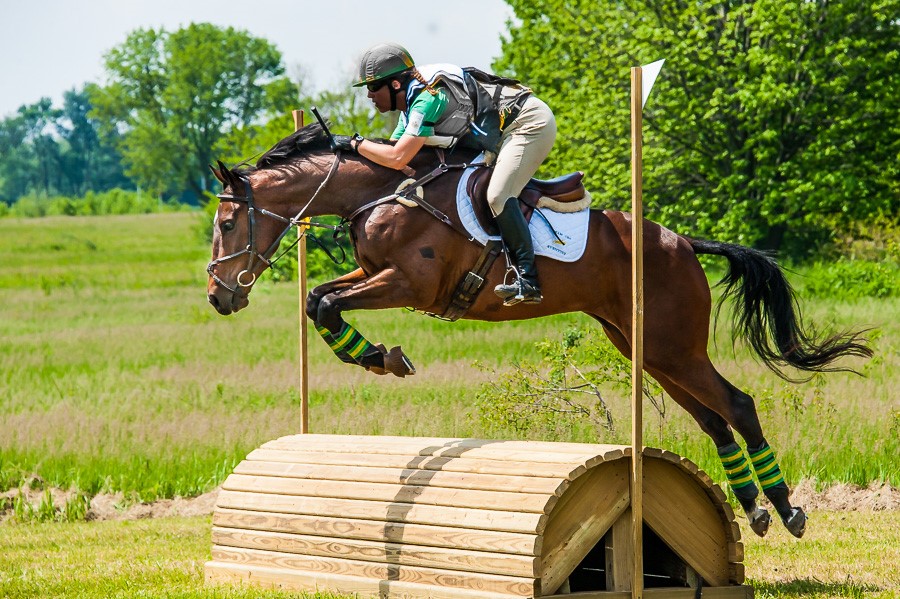 Clearing a jump at the Rolex 3-day event at Kentucky Horse Park. Photo by Thomas S. Woolf. Clearing a jump at the Rolex 3-day event at Kentucky Horse Park. Photo by Thomas S. Woolf.
|
Three-day events developed from trials for cavalry horses and attract both amateur riders and Olympic-level competitors. Amateur riders participate for the joy of training their personal horses to carry them over jumps on marked steeplechase or cross-country courses; professional riders make a career out of training horses for higher level three-day events in national and internationals competitions. Amateurs tend to use the horse they have regardless of breed or mix; professionals seek out horses of proven athletic ability and stamina, often Thoroughbreds or warmbloods.
The disciplines in a three-day event are dressage, a beautifully-executed dance performed by horse and rider working in perfect sync. Dressage is based on the training of war horses and requires the horse to respond effortlessly to almost invisible cues given by the rider.
In addition to dressage, three-day event horses must traverse a cross-country course of jumps that mimic a ride through meadows and woods. The jumps include a water feature and a variety of fences and other obstacles with long open gallops in between.
The third event is stadium jumping, a tight course of high jumps that leave no room for errors. Three-day events are part of the summer Olympics, the Pan-American Games, and other international competitions.
Modern cowboys and cowgirls participate in rodeo competitions that originated in the Western US when ranchers and wranglers got together at the end of a cattle drive or after a hard day on the range. Rodeo events include bronc riding, calf-roping, cutting contests, barrel-racing, and steer roping.
The Quarter Horse is the preferred breed for many rodeo events because of its even temperament, trainability, stamina, and athletic talent, but other breeds and crossbreds also compete. Bucking horses come from two sources: owners who could not train the buck out of a horse and breeders who produce stock with a tendency to buck.
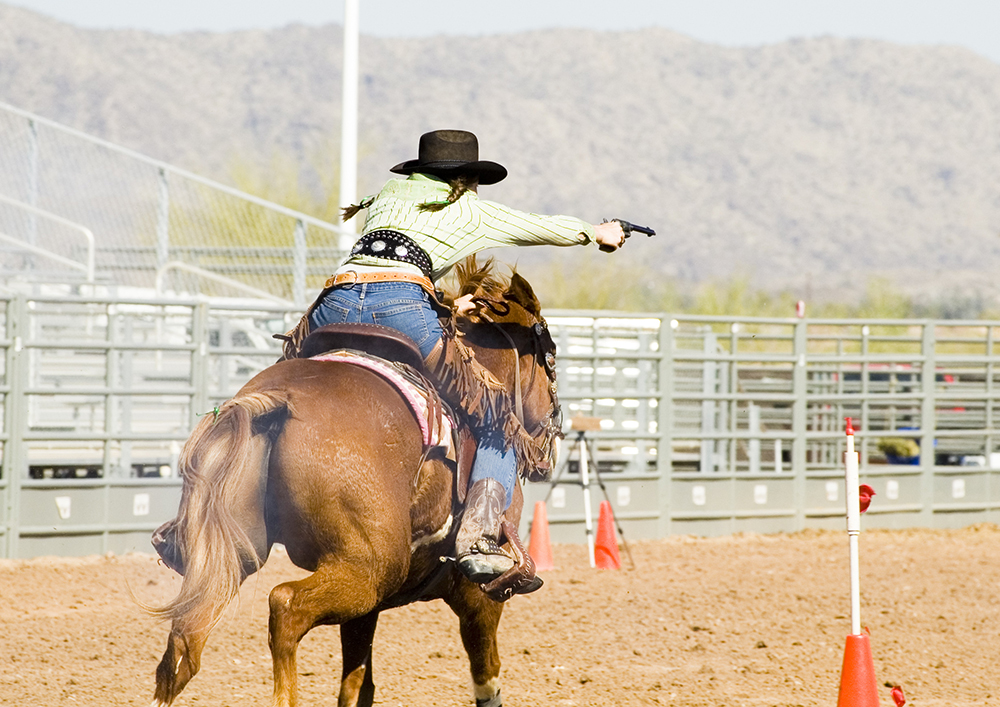 Mounted shooting is a fast-growing sport that requires a lot of skill! Mounted shooting is a fast-growing sport that requires a lot of skill!
|
Roping and cutting horses need the speed to chase down a calf or steer and the agility to spin and follow the animal so the rider can lasso the calf or catch the steer. Well-bred and trained Quarter Horses are the most common in these contests, but some competitors use Pintos or Paints.
Some rodeos travel the country, giving urban and suburban residents an opportunity to see some thrilling rides by some top competitors. The Professional Rodeo Cowboys Association tops off the rodeo circuit with the annual Wrangler National Finals Rodeo in Las Vegas in December. For more information, see PRCA’s website.
Cowboy mounted shooting combines barrel racing with marksmanship skills that were important in the Wild West. Claimed to be the fasted growing horsemanship sport in the US, mounted shooting involves firing blanks to break 10 inflated balloons on sticks attached to a set of barrels arranged on a course. Scoring is based on speed and accuracy with points lost for missing a balloon and for exceeding course time. Shooters dress in western attire and use two .45 caliber single action revolvers like those used in the late 1800's, each loaded with specially-prepared blanks.
Polo is an ancient game that originated in Central Asia as training for cavalry units and was played by royalty in Persia (Iran) and other Middle Eastern countries. The game uses agile horses, long-handled mallets, and a wooden ball; the object is to score points by driving the ball across the other team’s goal line. The game has retained its elitist connotation; the US Polo Association organizes polo matches through clubs in various states.
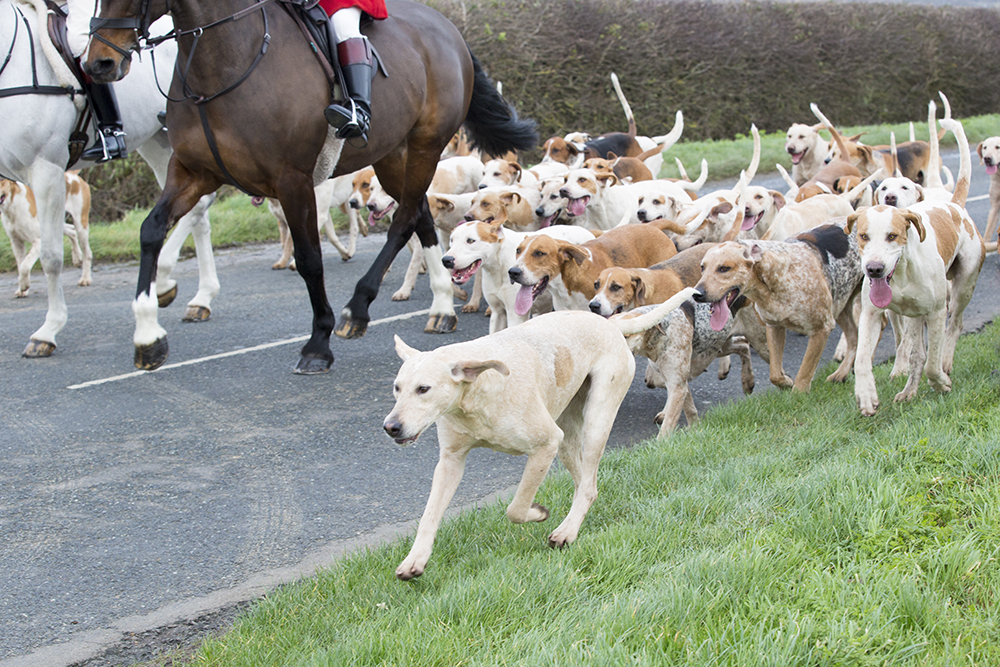 Fox hunting came to North America in colonial times. Fox hunting came to North America in colonial times.
|
Horsemen also ride in sports that use dogs to hunt foxes, coyotes, and bobcats or point upland game birds. Fox hunting came to North America in colonial times; today the Masters of Foxhounds Association governs hunts in 156 clubs in 37 states with a set of guidelines and bylaws that safeguard the private property they traverse, protect the animals they hunt, and provide for the welfare of their hounds and horses. MFHA focuses on enjoyment of a horseback ride in beautiful country behind a pack of hounds seeking and running its quarry. The pack rarely kills the fox; most often it goes to ground or outwits the hounds. Each fox hunt club has its own territory and cooperates with landowners who allow the horses and riders to traverse their property.
The type of horse used for foxhunting depends on the terrain, with Thoroughbred and warmblood crosses often used in fields and brushy areas with fences and walls to jump and fast, tough horses used in western coyote hunts over larger, rockier territories.
Sporting dogs such as Pointers and Setters compete in field trials to assess their ability to find and mark hidden quail. Since the trials cover large areas, the judges, handlers, and spectators follow on horseback, sometimes covering a dozen or more miles in a day. The horses used for field trials must have the conformation and stamina to do the job; the patience to wait quietly while the handler dismounts, flushes, and fires blanks at the bird; and the ability to work in adverse weather conditions. Since it must also be comfortable to ride, participants often select gaited breeds such as the Morgan or Tennessee Walker.
Some horse owners who enjoy trail riding enhance their experience by entering competitive trail rides hosted by the North American Trail Ride Conference. Horses competing in these rides must be able to cover at least 15-24 miles per day at the novice level and 25-35 miles per day at the open level. Competitions generally last two days with a maximum allowed distance of 40 miles for novice competitors and 60 miles for open competitors.
Horse shows allow professionals and amateurs to compete in events that display their breeding, training and riding abilities. Many of these shows are one-day events held at training and riding stables, but some take over county or state fairgrounds for several days or even weeks. For example, the annual Quarter Horse Congress at the Ohio State Fairgrounds lasts two weeks and includes Quarter Horse racing and contests to demonstrate skills necessary for working cattle.
Horse clubs are popular 4-H programs, and some high schools and colleges field equestrian teams that compete in state and regional events. 4-H clubs teach horse care and behavior to young people in grades three through high school. Pony Clubs of America also offer young people the opportunities to develop horse knowledge and horsemanship skills. 4-H clubs work with both English and western style riding; pony clubs teach English riding.
Although horses no longer haul goods from country to city, city to city, or door to door, they are treasured symbols of the American past and provide a link to the animal world for those who live in cities and suburban areas. Horse and carriage rides are a pleasant way to wend through city streets and urban parks; horse-drawn hayrides and sleigh rides provide respites from busy lives; and horse stables allow animal lovers some up close and personal time as they learn to ride and care for these wonderful animals.
Several cities have had vibrant carriage businesses but they are succumbing to sociopolitical campaigns based on false claims that the carriage rides are inherently cruel to the horses. Some cities have already banned the carriage business and New York’s city council is considering an ordinance to replace its iconic horse-drawn vehicles with electric cars. For details about the campaign to eliminate the carriage industry in the Big Apple, see “Carriage horses and drivers face extinction in NYC” beginning on page five of the 2014 NAIA Animal Policy Review.
Vacation ranches and horse camps are popular with horse lovers and provide or supplement a living for ranchers and camp owners. Dozens of western vacation ranches are members of the Dude Ranchers Association, a trade organization that helps members carry on the spirit and freedom associated with the American West. Dude ranches cater to riders at all levels of experience.
Riding stables provide opportunities to take riding lessons and trail rides close to home, and boarding stables allow city and suburban horse lovers to own a horse they can ride at their leisure. Many horse owners support their hobby by boarding a horse or two for a friend or acquaintance.
Horse expos such as the All American Quarter Horse Congress in Ohio and the Eastern States Exposition Horse Show in Massachusetts include trade shows and vendor arcades that feature dozens or even hundreds of booths selling horse-related clothing, equipment, and services ranging from T-shirts and riding habits to saddles, bridles, nutritional supplements, horse blankets, veterinary supplies, jewelry, artwork, horse trailers, and more.
Horse breeders and trainers earn or supplement their income producing horses suited for particular types of sports or jobs and training horses for themselves or for clients. Probably the most famous breeders and trainers are those involved in big purse Thoroughbred racing, but these are the tip of the iceberg. Thousands of breeders produce horses specifically for harness racing, rodeo work, various types of horse shows, carriage teams, stadium jumping, cross country events, and even parades. These hands-on horsemen and women are the protectors of rare horse breeds and the custodians of popular breeds that no longer have traditional jobs.
The popularity of horses also supports a huge publishing industry of magazines, websites, and books covering horse behavior, health, nutrition, training, breeding, riding techniques, equipment, and much more.
Many living history farms, reenactment groups, and museums highlight horses’ contributions to the period they represent. For example, Colonial Williamsburg has a stable of horses for driving and riding through the historic area to emphasize the importance of horses in the 18th Century; western groups use horses in sheriff’s posses and hitched to stagecoaches and buckboards in their performances; and Civil War reenactors use horses for cavalry and to haul cannons and ammunition wagons.
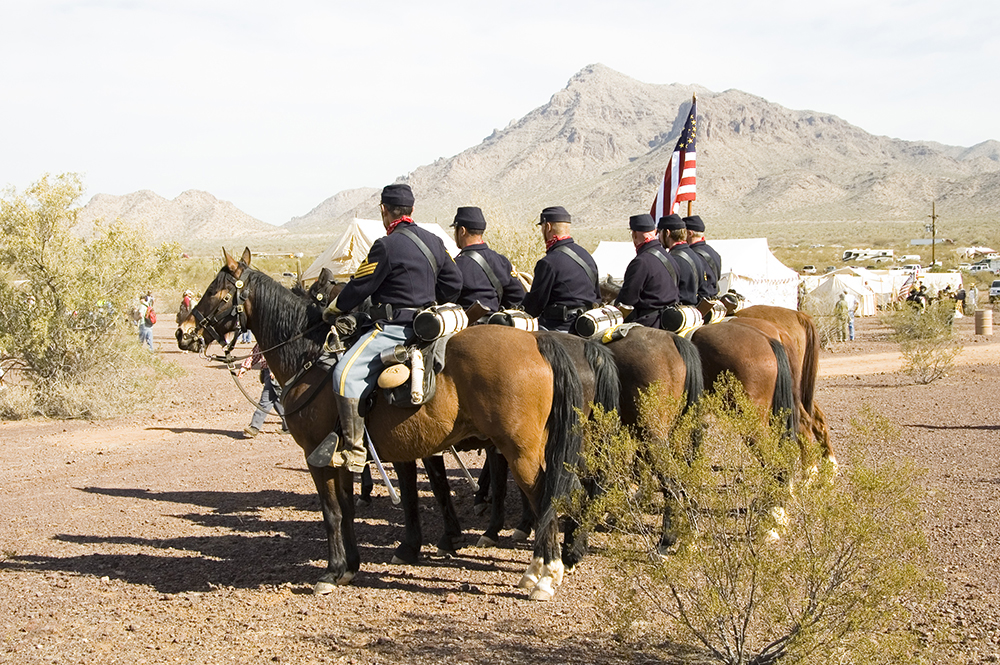 In the 19th century, horses were used in the US Civil War... today, they take part in reenactments. In the 19th century, horses were used in the US Civil War... today, they take part in reenactments.
|
Living History Farms in Iowa features farming from 1700-1900 with emphasis on horse power in the 1900 Horse-Powered Farm, and Kentucky Horse Park mixes historical information about horses with modern events and exhibits. Its International Museum of the Horse is affiliated with the Smithsonian Institution and highlights equines from prehistoric Eohippus to modern sports. The complex also houses a museum of horse-drawn equipment and related items.
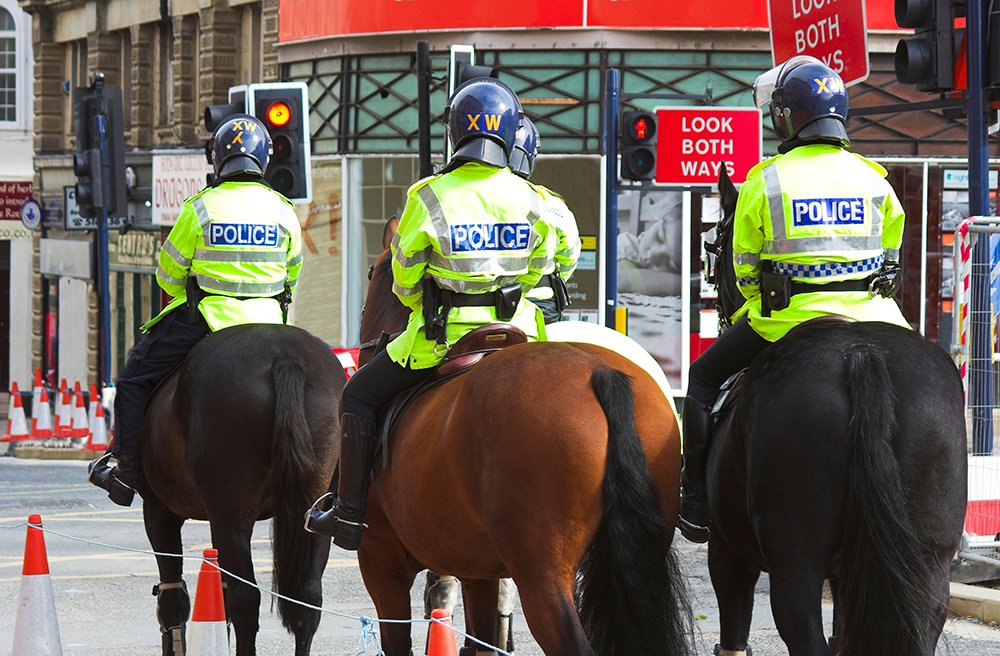 Mounted police attract attention and provide a positive encounter with police officers. Mounted police attract attention and provide a positive encounter with police officers.
|
Many cities use mounted police units for a variety of purposes from crowd control and park patrol to search parties and public relations. Horses attract attention and provide a positive encounter with police officers; a mounted officer has a better vantage point than a foot patrolman and is often more maneuverable than an officer in a patrol car; and horses can cover more ground in remote areas during searches for lost children and fleeing criminals. Horses selected for police work must be calm and steady in a crowd, and trained to ignore traffic motion, gunshots and other noises.
The relationship between an officer and his horse goes beyond simply caring for the animal and riding along city streets to the development of a deep trust between man and animal. The officer depends on the horse to keep him safe, and the horse must learn that the officer will return the favor. The US Mounted Response Training Center and National Mounted Police Services, Inc. are two of several schools that offer classes and clinics in the use of horses for law enforcement and related purposes.
Federal, state, and local park rangers also use horses to patrol roadless areas, back country wilderness, and mountainous terrain, but military use is now limited to mostly ceremonial events.
The magic of horses spreads beyond sport, work, and passion to aid for physically, mentally, and emotionally disabled children and adults. Equine-assisted therapy runs the gamut from just being around horses to touching, grooming, riding, and driving for a broad range of help for those afflicted with autism, learning disabilities, illnesses, injuries, and emotional traumas and military members and veterans with service-related injuries.
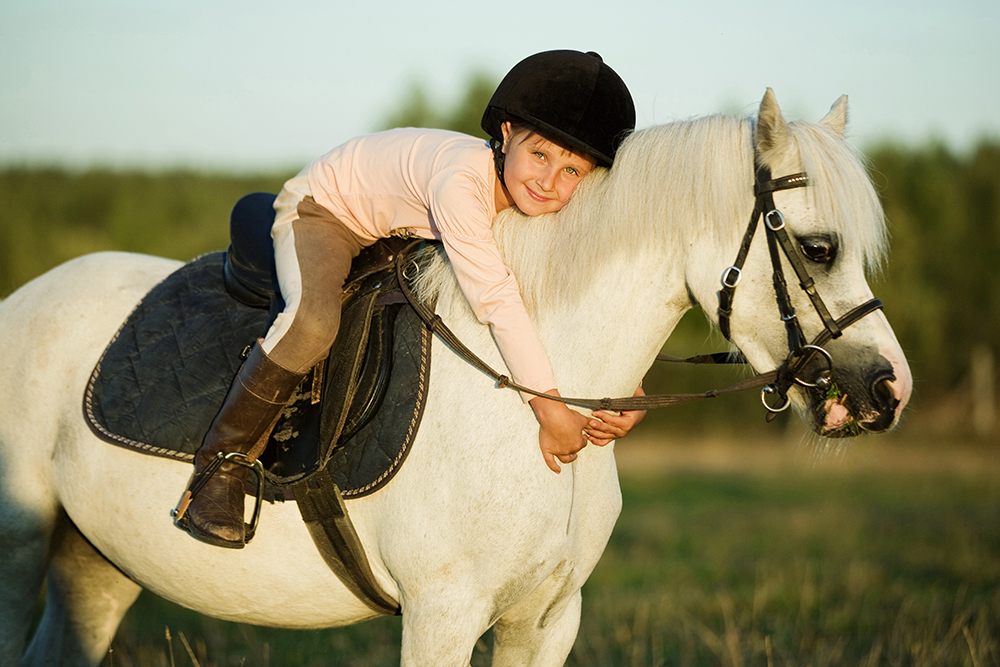 Magic: simply touching or grooming a horse or pony can brighten your day! Magic: simply touching or grooming a horse or pony can brighten your day!
|
The Professional Association of Therapeutic Horsemanship International (PATH Int’l) is a world-wide association of equine assisted therapy centers that offer occupational therapy, physical therapy, and psychotherapy programs to help clients meet physical and mental challenges caused by injuries and debilitating illnesses. Building on the natural bond between people and horses, PATH centers work with medical and psychological professionals and therapists to design and implement programs for their clients.
PATH centers range from small private farms or stables with an instructor or two who use their own horses to large corporations with boards of directors, dozens of horses and instructors and 100 or more volunteers. PATH has more than 800 centers that utilize more than 4500 certified instructors, and serve more than 58 thousand clients and 3300 veterans and active duty service members.
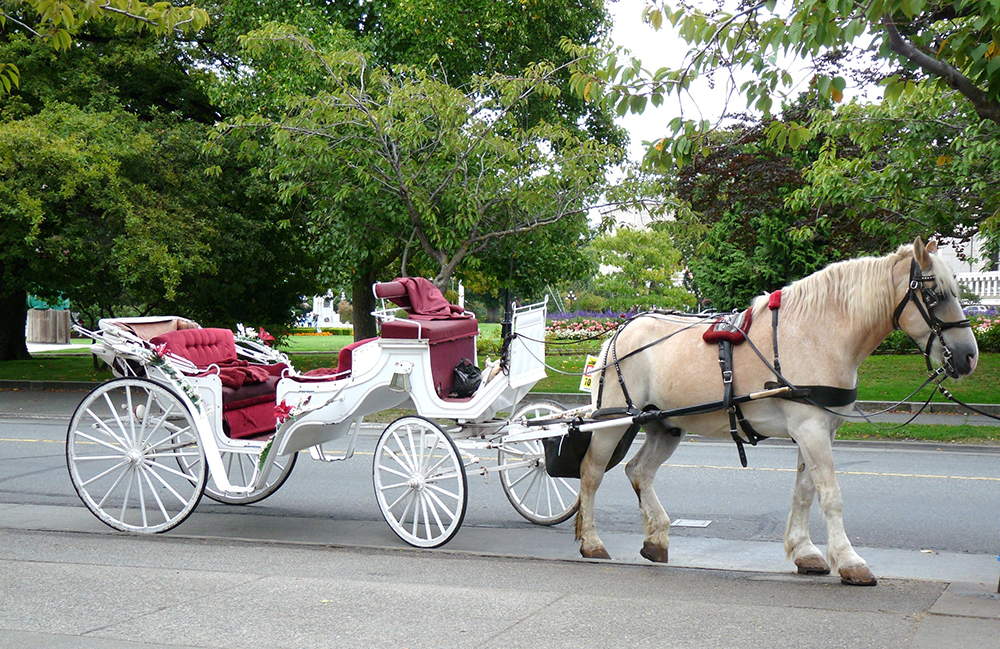 Carriage Horses have been part of New York City for 150 Years. Carriage Horses have been part of New York City for 150 Years.
|
As often happens in our relationship with animals, changing times have resulted in changing attitudes towards horses. Once kept strictly as working animals, mounts for warriors, and perks for royalty, modern horses rarely work, almost never go to war, and are within reach of millions of potential owners and riders. As a result of this shift, those who work and play directly with horses as a job, career, avocation, or passion are increasingly at odds with those who believe horses should live in the fields free from such strife.
The battle over the carriage horse business in New York City exemplifies this dichotomy. For 150 years, carriage drivers have operated in the city, providing rides for tourists and lovers and offering city residents the opportunity to touch and talk to their horses. Laws govern their operation; horses can’t work when it is too hot or cold and must have veterinary care, adequate stabling, and a vacation every year. Veterinarians and other horse experts report that the horses are healthy and not under duress, and the vast majority of New Yorkers want them to stay.
However, the city’s mayor and radical animal groups decided that pulling the carriages is inherently abusive to the horses and teamed up to ban the businesses and replace the carriages with electric cars. The mayor wants the ban to fulfill a campaign promise; the activist groups want the issue to raise money, and a developer reportedly has an interest in the stable real estate.
Since the campaign to end elephant acts in circuses, the attempt to ban carriages in New York City is the most dramatic battle between those who believe in stewardship and the working partnership of people and animals versus those who want to segregate people from traditional and beneficial human-animal relationships. And it is not the only attempt by activists to sever this bond; they also condemn rodeos, horse racing, the harvesting of mare urine for use in hormone therapy for women, and the round-up of feral horses in the Western US. In each case, they claim that greed motivates an activity that is inherently abusive, an accusation that stirs emotions and opens donor checkbooks. The fact that these sports and other businesses govern themselves with self-imposed animal welfare policies and regulations gets lost in the rhetoric, allowing radical groups to gain publicity, power, and millions of dollars in their deceptive campaigns.
It is true that there are few federal regulations that govern horse care. The US Department of Agriculture Animal Plant Health Inspection Service regulates transport of horses to processing plants, and bans soring, a method of increasing the natural high-stepping gait of several breeds of horses.
Activist campaigns effectively ended horse meat processing in the US, but unwanted horses may still be sold for meat and transported to Mexico or Canada for processing. Zoos use horsemeat for carnivores, and Europeans consider it a delicacy. The ban has had unintended consequences because it has limited opportunities for owners to sell unwanted horses in hard economic times in a glutted market. Some observers believe that the ban has increased the numbers of abandoned horses, resulted in cruelty and neglect when owners can no longer afford quality food for their animals, and overwhelmed horse rescue sanctuaries. See ”Slaughter bill is not in best interest of horses” and “The unintended consequences of a ban on the humane slaughter (processing) of horses in the United States.”
Feral horses and burros in the western US are overgrazing portions of their habitats, so the federal Bureau of Land Management conducts round-ups to thin the populations. The feral animals are the descendants of horses and donkeys turned loose or escaped from ranches and settlers generations ago. Many resemble the Spanish type so prevalent in the early West, but some are descendants of draft horses and other types. BLM thins each herd periodically using humane trapping and handling techniques developed by livestock expert Temple Grandin. The horses receive veterinary care if necessary and are put up for adoption. Unfortunately, there are more horses than homes in a slow economy, and BLM spends millions of dollars to keep them in permanent centers.
Some animal activist groups claim that BLM gathering methods are cruel, but several reports by horse experts have found them to be humane. According to the BLM website:
“Two reports issued in the fall of 2010 (one by four independent, credentialed equine professionals and one by the Interior Department’s Office of Inspector General), plus another report released in 2011 by the American Association of Equine (Veterinary) Practitioners, found -- without any ideological or political bias -- that the BLM’s gathers of wild horses are conducted in a humane manner. The Inspector General determined that the BLM’s gathers are "justified" and reported that the agency ‘is doing its best to perform a very difficult job.’”
Horses and horse owners are subject to several categories of laws and regulations, including local zoning ordinances; federal, state, and local cruelty and neglect laws; and anti-pollution rules that determine where
stables can be located, trail rides can take place, and manure can be dumped.
Kids, especially girls, have a special affinity for horses and are welcome to participate in horse activities. And there’s plenty of opportunity for them to do so.
Pony Clubs of America uses lessons in riding and horse management to foster leadership, character, and confidence in young people while developing skills and participating in horse-related activities. There’s no minimum age for membership in a local pony club, and young people can remain members until they reach 25 years of age. Members must have access to a pony or horse; if the family does not own a horse, the child may lease or borrow a mount.
Parents and other volunteers operate local pony clubs; each club determines its own programs and may teach about a range of horse activities from horsemanship, dressage and polo to fox hunting, three-day eventing and even games on horseback.
USDA’s Cooperative Extension Programs at state land grant universities include 4-H clubs for young people aged nine-to-nineteen years. Curriculum includes riding skills, horse care, and competitions; members produce projects to display at county and state fairs to represent an aspect of horse health or care. County agricultural offices supervise 4-H clubs that are led by parents and other volunteers.
Other organizations that offer special programs for young riders include the US Dressage Federation, United States Eventing Association and the Interscholastic Equestrian Association. Families may also consider a riding vacation at a dude ranch or a horse camp for their children.
The benefits of riding and caring for horses cannot be overstated. Young people learn to care for an animal of another species, gain skills and confidence, develop balance and improve coordination, participate in physical activity, and meet tough challenges as they gain riding skills. And a child who learns to ride a horse has an enjoyable activity that can last a lifetime.
Most everyone who has a dog knows that dogs can do tricks as simple as “roll over,” “gimme five,” and play dead, and those who opt to compete in agility, obedience, and field trials can put together more complex strings of behavior. But few horse owners consider teaching their horses the simple tricks and multipart ations for fun and good management.
Enter click and treat training, a method that uses a sound as a precursor for a treat reward.. As soon as the horse learns that the click is followed by a treat, trainers can use the sound and snack to reinforce a behavior they have guided the horse to give, can lure the horse into offering the behavior, or can reward a behavior freely offered by the horse.
The clicker is not necessary to the process but does make it easier. The key is the reward, not the clicking sound, but the sound reminds the horse that the reward is on the way. To keep the horse’s mind on business, it is important that the reward be easy to eat, highly desired, and easy to handle. The trainer should always follow the treat with words of praise and pats so he can eventually skip both the click and the treat and use a word or body cue to tell the horse what he wants.
It’s easier to teach tricks to a horse that is already accustomed to people working around him on the ground, especially if you plan to guide or lure the horse into learning, and the clicker can help with that process. The website Equine Clicker Training has volumes of information about using the clicker and teaching tricks and helpful behaviors with clicks and treats. The article “Winter exercises” includes a list of tricks and behaviors to jumpstart ideas for winter activities when riding opportunities are limited.
Karen Pryor’s Clicker Training website has good information about using the clicker with many species of animals, and Alexandra Kurland’s The Clicker Center is specific for horse training. Kurland has also written books and articles about clicker training horses and has developed an on-line course to teach the technique.
Clicker training, like any successful training method, takes time and patience, but the rewards for the horse, the trainer, and their relationship are well worth the time and effort.
 Discover Animals is a web-based educational resource offered by the NAIA
Discover Animals is a web-based educational resource offered by the NAIA